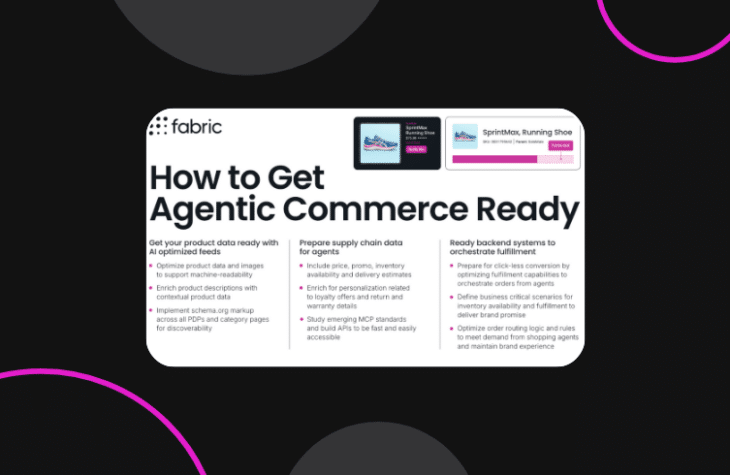Insights From the Floor: 3 Takeaways From Shoptalk 2025

I’ve arrived back home from a great week of meetings, informal chats, and team building at Shoptalk 2025. Thinking back on the past week, it’s remarkable how much was jammed into a few days in Las Vegas. As Director, Product Marketing at fabric, my focus was to better understand the pains that retailers are facing in 2025, take in sessions to hear from experts on where the industry is heading, and take the pulse of other vendors to better understand the technology landscape.
Top 3 insights from Shoptalk 2025
1. Agentic AI’s disruptive unknown
AI was everywhere and in everything. Talking to vendors around our booth the joke was, “And how are you integrating AI?” Everyone had a chuckle and then said, “Let me explain.” I laugh now at the fact this was no joke.
I found that for the most part AI is being used to drive efficiency for administrators. Adopting LLMs to streamline efforts for product data ingestion, offset customer support costs, and build customer profiles for personalization has gone mainstream. But, I found that the question on retailers’ minds is, ”When will Agentic AI eat my lunch and start competing with direct and organic traffic to my DTC site?” Said another way, when will retailers lose control?
I jokingly refer to this as the moment Skynet becomes self-aware. If you’re a fan of Terminator 2, you’ll get that reference.
The answer is soon.
Jordan Berke from Tomorrow spoke to five keys for retailers over the next five years. One of them focused on A2C (Agent to Consumer) commerce. Think of this: e-commerce sites saw referral traffic from agents increase by 1300% over the 2024 holiday season—that’s 13x growth. Nearly 50% of Americans are regularly using agents. More than half of them are replacing Google, Amazon, and Walmart as the starting point for their purchase journey. Perplexity already offers ‘Buy with Pro’ for brands like On, Best Buy, and Shopify retailers through their integration.
So, what do retailers do about this? What are ways to prepare for the day Skynet becomes self-aware… the day that agentic commerce reaches mass adoption?
To answer this, let’s think about product data as IP. Agents will find it, scrape it, and serve it up. Retailers could block them but then they’re losing out on the reach of these powerful referral channels today. The best approach for retailers will be to harness the power these agents offer by serving them with enriched, brand-controlled product data through fabric’s Product Catalog offering to maintain control of your product data / IP. Focus on making sure that agents are presenting customers with the right information. As the A2C channel matures and your organization is ready to support transactions, let fabric AI Order Cloud orchestrate the order lifecycle.
A2C represents yet another channel for retailers to consider in the coming 12-18 months. It’s best to be prepared with the right technology to manage demand and control the fulfillment journey.
2. Business fundamentals are back in style
The first talk I attended was the most impactful for me. As someone who recently went back to school, I’m annoyingly curious and love to hear about retail business strategy. Simeon Siegel, a Senior Analyst and Managing Director at BMO Capital Markets, spoke about how he evaluates retail businesses. He started with a bold take:
“Voice of the Customer is important, but running a business in reaction to customer tastes and sentiment in 1P data or KPIs is expensive and short-sighted. Now more than ever, the job of a retailer should be in creating a connection with customers for years to come, that’s brand building.”
It was music to my ears. He went on to describe how he evaluates companies based on their long-term outlook, and he encouraged retailers in the audience to consider whether their strategies emphasize what they’re selling as much as how they’re selling it.
In a separate but related talk, Adrienne Yih, Managing Director & Senior Analyst at Barclays, framed the mission for retailers as, “We’re here to grow market share—profitably. Can we manage inventory, cut expenses, manage the supply chain?”
These business fundamentals are often overshadowed as businesses scale and bloat with process, siloed decision-making, and bureaucracy. For some retailers, getting back to basics in 2025 is essential.
These sentiments were validated by the number of inquiries we had at our booth and from what I heard during my 1:1 meetings on the floor:
- Can fabric solve my inventory availability problem?
- Can fabric solve my inventory placement problem?
- Can fabric help me reduce split shipments and optimize fulfillment across my retail network?
I didn’t make these up. These are real questions I received in every meeting I had on the floor, all having to do with fundamental challenges affecting resources, margin, and customer experience.
And the answer is yes.
fabric is designed specifically for these problems—to offer retailers, and specifically their merchant operators, the ability to see one view of orders and inventory in real-time, and to manage orchestration rules, routing logic, and fulfillment networks within the interface—NOT with code.
Retailers that can build and sustain a brand through repeated positive experiences with customers over time will weather macroeconomic headwinds in 2025 and likely find themselves on Simeon and Adrienne’s desks as companies to invest in.
3. Technology decisions
Perhaps my best conversation at Shoptalk was my last one. I sat next to an innovation lead at a global apparel retailer on the plane ride home. We exchanged lessons from the conference and then started talking more specifically about retail technology and innovation.
He framed technology decisions in a really interesting way: “What will it cost us to rip this technology out if it doesn’t work?”
The question is so simple yet it must be very hard for businesses to assess as the impact of a failed deployment could mean hard costs to remove the tech as well as the reputational hit from customers and opportunity costs of not going in a different direction.
It’s a stark reminder that composable commerce isn’t foolproof. There are real risks to fragmenting your architecture across best-of-breed systems and real costs to implementing, maintaining, and possibly replacing services and systems if a very narrow balance isn’t met. With all of the vendors present at Shoptalk, which is the right one, or right ones, for your business?
It’s a reminder to be disciplined in evaluating technology and choosing partners and products that will provide flexibility over the long term. The old salesman in me believes this is another reason why fabric is a great fit for retailers looking for stability. Since our products are all part of the same cloud offering, Product Catalog, Order Orchestration, and Dropship offer one platform to facilitate product enrichment, omnichannel order journeys, and supplier onboarding.
Action these insights
The three insights—Agentic AI disruption is coming faster than we expect, retail business fundamentals are cool again, and flexibility is key to technology decision-making—will drive me in the coming months to evaluate how fabric will support businesses seeing and saying the same thing.
Now, it’s time to catch up on my sleep. Until next year, Shoptalk! In the meantime, schedule a demo with us to see how fabric AI Order Cloud is built for AI-powered commerce.

Director, Product Marketing @ fabric





